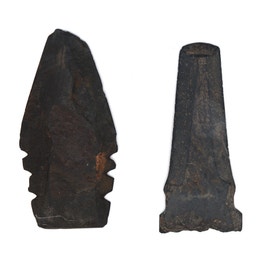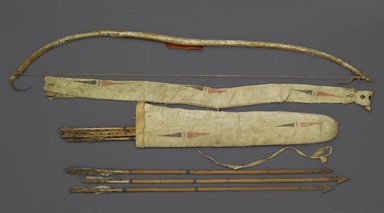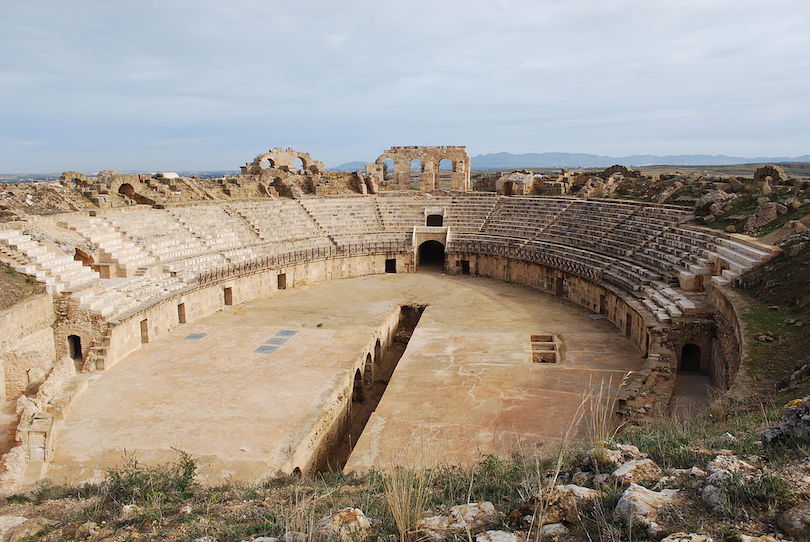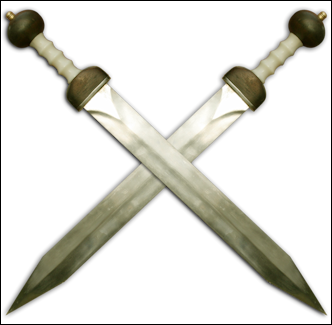Timeline of Military Technology
by Cole Wilson⬇
(keep scrolling throughout the whole presentation!)



According to the World Book Encyclopedia, the earliest prehistoric weapons were rocks and sticks. Sometimes these would be sharpened into crude spears and knives, although many times they remained blunt. These early weapons were essential to humankind not only for protection, but also for hunting and food. Early humans did not have the sharp claws or long teeth that many animals did, forcing them to hunt for their food in other more innovative ways.
The early human's discovery of the rock and stick for use as a weapon was one of the most important of the time. This was because it marked a shift away from more "animal-like" behavior of the past, and into the era of tools. The world is different today because without weapons such as these, it is unlikely our ancestors would have survived, as they would have been killed by animals or have starved to death.
* citations are at the end of the presentation
The next big step in the history of weapons and military technology was the invention of the bow and arrow. According to the Encyclopedia of Science, Technology, and Society, the bow (and arrow) was mainly the first device that allowed humans to propel projectiles for large distances. In addition, arrows were easy to fashion and did not take much space to store.
This invention was hugely important for hunters and armies. This was because it allowed them to engage their enemies or prey without the hand-to-hand combat associated with spears and knives. This enormous leap was a very significant one because it "changed the rules of the game" (so to speak), making it necessary for people to develop projectile weapons in order to win in a fight. For the first time, people were stepping away from the crude weapons of the past and into the more technological future. Without this "next step," it is unlikely we would have ever moved past simple rocks.
* citations are at the end of the presentation


The introduction of metal into warfare pushed society into more military-minded civilizations, such as those of the Spartans, Romans, and Greeks. The bows and arrows of the past continued to play an important role, but the sticks and stones of the past were replaced with metal equivalents. Knives and stone daggers were quickly replaced with metal blades that were sharper and better made. The rock-tipped spears were replaced with long shafts of metal, perfect for stabbing.
Among the many wars fought with metal weapons, the Trojan War is chief among them. Fought between Greece and Troy in the 12th century BCE, it was made famous by the epic poem The Iliad, by Homer. Within it's many pages, it describes the infamous battle between Hector and Achilles:
Hector brandish his sword and spring upon Achilles. Achilles mad with rage darted towards him, with his wondrous shield before his breast, and his gleaming helmet, made with four layers of metal, nodding fiercely forward.
Myth or not, this "recounting" of a battle of the time mentions many metal weapons and defenses, such as swords, helmets, and shields. It offers us a valuable look into the past.
* citations are at the end of the presentation

According to the World Book Encyclopedia, gunpowder was invented in China around 850 CE. Originally, says the encyclopedia, "the Chinese developed gunpowder fireworks for ceremonial purposes." Soon however, they realized the potential for warfare. The innovation quickly moved from devices like fiery arrows to heavy artillery like cannons. Things moved on further to smaller firearms that could be carried.
The discovery of gunpowder was the perhaps biggest invention to date. Not only did firearms enable armies to shoot from longer and longer distances, but it also added to the "scare effect." Large booms and flashes of light would often terrify an enemy even more than the actual bullets would.
Gunpowder would take weapons into the future, providing the means for bigger and bigger weapons further on. Modern weapons such as the bazooka and machine gun could not have been created without gunpowder.
* citations are at the end of the presentation
Starting with Wilbur and Orville Wright's initial flight at Kitty Hawk, airplanes would change the world forever. On the surface, it is hard to imagine airplanes as anything but an efficient travel device. But there is no doubt about it: planes took warfare into the twentieth century.
The Encyclopedia Britannica says that at the start, "aircraft were unarmed and employed for reconnaissance, serving basically as extensions of the eyes of the ground commander. Soon, however, the need to deny such reconnaissance to the enemy led to air-to-air combat in which each side tried to gain superiority in the air." World War Ⅰ was the birthplace of air warfare, and it caused military tacticians to focus not only on land and sea, but air as well. The opening of this new "third domain" was one that would jump-start the creation of many new deadly technology, such as unmanned drones, "smart bombs," and stealth fighters.
* citations are at the end of the presentation
Out of every weapon mentioned so far, non is as devastating and terrible as the "nuke." Nuclear weapons (which were invented around World War Ⅱ), are atomic bombs that can kill millions in one go. A nuclear bomb is one of the three types of "weapons of mass destruction" to be popularized, in addition to chemical and biological agents.
According to the World Book Encyclopedia, the first (and only) military use of a nuclear bomb was when the US bombed the Japanese cities of Hiroshima and Nagasaki during World War Ⅱ. This caused the war in the Pacific to end, as Japan surrendered shortly after the bombings. Such destruction and death had never been seen on that scale before, and the world would never be the same.
* citations are at the end of the presentationAll of these militaristic advancements leads one to wonder... what's next? There are many possibilities, but one likely one is cyberweapons. Computer viruses and worms already have the ability to wipe out entire banking systems, what would happen if they could knock out our power grid too? Such things have already happened in places like Ukraine by places like Russia. The evolution of computers has offered a fifth threat vector to nations: land, water, air, space, ...and now cyberspace.
The following research sources were used:
Bix, Amy Sue. "Weapon." World Book Advanced, World Book, 2022, www.worldbookonline.com/advanced/article?id=ar596100. Accessed 30 Jan. 2022. DeVries, Kelly. “Bow.” Encyclopedia of Science, Technology, and Society, Vol. 1, Facts On File, 1999. History Research Center, online.infobase.com/Auth/Index?aid=106417&itemid=WEHRC&articleId=273293. Accessed 29 Jan. 2022. Homer. The Illiad. Translated by Samuel Butler, MIT Classics, 1994, MIT Classics, https://classics.mit.edu/Homer/iliad.mb.txt, Accessed 28 Jan. 2022. Kroenig, Matthew. "Nuclear weapon." World Book Advanced, World Book, 2022, www.worldbookonline.com/advanced/article?id=ar396520. Accessed 30 Jan. 2022. MacIsaac, David. "air warfare". Encyclopedia Britannica, 18 Jul. 2016, www.britannica.com/topic/air-warfare. Accessed 30 January 2022.
In addition to the already cited images, these were also used:
globe (WikiMedia): https://upload.wikimedia.org/wikipedia/commons/thumb/2/22/Earth_Western_Hemisphere_transparent_background.png/1200px-Earth_Western_Hemisphere_transparent_background.png rocks background (summitpost.org): https://sp-images.summitpost.org/524235.JPG?auto=format&fit=max&h=1000&ixlib=php-2.1.1&q=35&s=5410e3733943161f002b944afc05e2c6 bow and arrow background (CNN Travel): https://cdn.cnn.com/cnnnext/dam/assets/150907165336-beautiful-mongolia12-all-that-space-2.jpg ampitheatre (Touropia): https://www.touropia.com/gfx/d/roman-amphitheaters/uthina_amphitheater.jpg great wall (AirBnB): https://images.adsttc.com/media/images/5b63/0d9b/f197/cc8a/0200/02f7/large_jpg/01_-_Hero_Shot.jpg?1533218185 fireworks: videezy.com airfield: https://c.pxhere.com/photos/b7/05/omaha_airfield_airplain_hangar_america_1940s_usa_transportation-623697.jpg!d explosion GIF: tenor horses: https://freepngimg.com/thumb/horse/1-2-horse-png-9.png arrows: https://www.onlygfx.com/wp-content/uploads/2017/06/bow-arrow-1.png "cyber" text: Cole Wilson